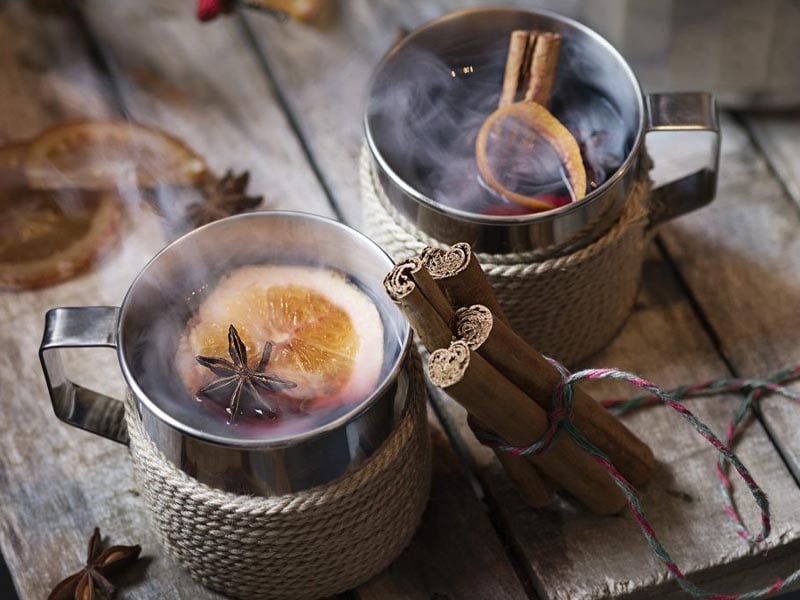Ancient Mulled Wine - Glühwein

Just after opening City Vino, we were approached by Lt. Blender to sell these cocktails, or winetails, in a bag. Fun MRE size bag that you pop a bottle of wine into, and water, then freeze to make a wine slushy. There are all sorts of flavors for both summer fun and winter fun. Lieutenant McMorris was a U.S. paratrooper who had an assignment in the Caribbean Islands. The story goes that he was invited to all the parties because he had the blender and would concoct tasty fun things for all kinds of social events. When he got home to Galveston, Texas he bought a run-down ice cream factory, and started making and distributing the bags you see in the store.
Winter fun, most popularly, has been the Lt Blender Mulled Wine, to which we are adding the 2020 Scheid Vineyards Craftwork Old Vine Zinfandel from Monterey California. So, the mix of cinnamon, cloves, and allspice from the Lt Blender Mulled Wine package complements the plum, black cherry, red flowers, blackberry, dried red fruits, and baking spices of the Zin. City Vino will be tasting this for December’s First Friday stay open late event.
Apparently, the idea of mulled wine really started long ago in the land of Egypt. Really! Circa 3150 BC. The ancient Egyptians initially used it for medicinal purposes and considered a healing elixir for the afterlife. Today we know that red wine is a great source of antioxidants. This increases levels of HDL (good cholesterol) and can significantly reduce the risk of heart disease associated clogged arteries. Cinnamon boasts potent anti-inflammatory properties and nutmeg is a powerful tonic that rids the liver and kidneys of toxins. Egyptian medicinal wine included ingredients like pine resin, figs, balm, coriander, mint, and sage.
The Romans, recognizing the need to preserve excess wine, ingeniously concocted mulled wine by infusing it with honey and an assortment of spices to enhance its flavor. As they traversed through Europe, this creation disseminated across nations. During the Middle Ages, mulled wine gained widespread popularity and was believed to impart health benefits due to its rich blend of spices. The Romans' deep-rooted affinity for wine extended to their conquests, as they brought skilled winemakers and viticulturists to establish vineyards in newly conquered territories. Historical records from the Roman Empire, including writings by Pliny the Elder and Marcus Gavius Apicius, attest to the infusion of herbs and spices into wine. The Romans' extensive travels, spanning from the Rhine and Danube rivers to the Scottish border, facilitated the spread of their spiced wine, known as Pimen (or Piment). Early recipes featured a captivating array of ingredients such as spikenard, cardamom, cinnamon, saffron, ginger, and honey. Beyond seasoning wine, the Romans experimented with viticulture techniques, including planting.
In the 1400s, spiced wine, known as Hippocras in recipes, was named after the Greek philosopher Hippocrates. A conical cloth filter bag called a Hippocratic sleeve was attributed to him. As the popularity of hot spiced wine grew, it became a staple in Europe and the Middle East, especially during winter, cherished for its warmth and pleasurable taste, along with perceived medicinal and aphrodisiac properties.
The origins of Glühwein can be traced back to around 1420, with the oldest documented tankard attributed to Count John IV of Katzenelnbogen, a German nobleman renowned as the first grower of Riesling grapes. The name "Glühwein" itself stems from the red-hot irons historically employed to heat the wine in various Germanic cultures when the beverage initially gained popularity centuries ago. Early manifestations of Glühwein are exemplified by a gold-plated tankard. The recipes have endured over the years, featuring a red wine base blended with seasonal spices like citrus, cinnamon, star anise, cloves, and vanilla, sweetened with sugar. Optionally consumed "mit Schuss" (with a shot), often rum or another spirit, the drink has evolved into various German variations, including white wine-based Glühwein and the fiery spectacle of Feuerzangenbowle, where a flaming rum-soaked sugar loaf drips into the wine. Heidelbeerglühwein is a blueberry mulled wine. Kinderpunsch is a children’s punch. Despite these options, the traditional red Glühwein, typically served in environmentally friendly mugs, remains a perennial favorite, allowing patrons to retain their Pfand (deposit) and cherished cup.
The Crusades played a pivotal role in spreading spiced wine knowledge across Europe. During this time, typical flavorings included cinnamon, ginger, cloves, paradise, and long pepper. The use of sugar, rather than honey, became a symbol of rank, as sugar was considered a luxury item with perceived medicinal values. Different European countries developed their interpretations of mulled wine, reflecting their cultural identities.
Medieval Poland added cream to mulled wine, creating a refined wine soup for breakfast. Victorian English mulled wine included sweet wine, water, lemon peel, lemon juice, and nutmeg. Spain's original Sangria was cold, spiced wine with cinnamon, ginger, and pepper. Spiced wine expanded globally during imperialism, adapting to local preferences in countries like Brazil and Chile. French Bordeaux spiced wines, called Clairet, evolved into modern Vin Chauds, often prepared with fruits and fortified with Cognac. England contributed various spiced wines like Wassail and classic Mulled Wine. The Nordic Gløgg included raisins and almonds, while the German Glühwein, meaning "glow-wine," gained popularity during Christmas holidays. The Dutchies prefer lemons to oranges. Whilst in Moldova they add black pepper and honey. Across the pond in Quebec, they have made it a bit more Canadian friendly by adding maple syrup to the wine.
Charles Dickens elevated mulled wine into a traditional holiday drink, featuring it in several books and solidifying its place in Christmas culinary history with its appearance in "A Christmas Carol." Perhaps you will be sipping upon mulled wine as you enjoy Stagedoor’s interpretation of the play.

Comments
Be the first to comment...